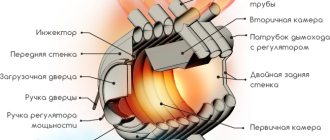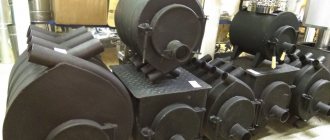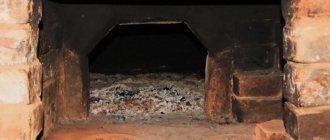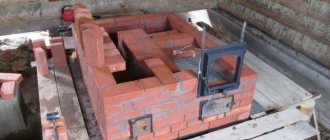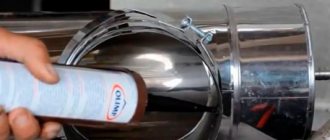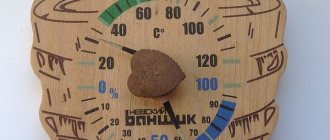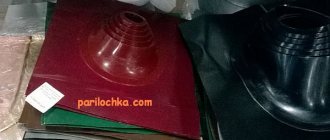The combustion process and the mechanism of pyrolysis
The main physical phenomenon, without which it is impossible to imagine the operation of any furnace, is the oxidation of various substances by oxygen contained in the air.
Fire, tamed by our ancestors millions of years ago, has become so familiar today that we don’t even think about how combustion occurs, with which each of us has been familiar since childhood. The seemingly simple question “how does wood burn?”, in fact, requires a separate explanation. After all, without understanding the basics, we will not be able to understand how economical pyrolysis furnaces work and why they are so good and economical. Actually, the formation of a flame occurs in several stages:
- First, the wood heats up and dries, releasing water vapor into the environment, which prevents fire from starting. This requires an external source of energy, which is usually flammable paper, kindling liquid, or a pile of small burning wood chips.
- Firewood, which from a chemical point of view is a complex organic structure, consists of three main elements: carbon, hydrogen and oxygen. When heated, wood disintegrates, and these components, in the form of various simple gaseous compounds, begin to be released into the surrounding space. The general name for all substances formed during fuel heating is pyrolysis gases, and for the process itself is pyrolysis.
- At the next stage, the wood decomposition products ignite and accelerate the pyrolysis of the remaining logs more and more, providing the fire with fresh fuel.
- In the end, the tree burns, leaving behind some of the coals that did not have time to react with the oxidizing agent.
How combustion occurs
Actually, the idea that made it possible to build long-burning furnaces is to ensure the most complete decomposition of fuel in such a way that after its use there is practically no unburned waste left. To do this, it was necessary to slow down the pyrolysis as much as possible so that the entire volume of firewood would gradually and completely disintegrate into pyrolysis gases.
Description of design and operating principle
Initially, in essence, it is an ordinary metal stove, whose task is to heat the room by directly heating the air. Another thing is how this heating is implemented. The heater does not heat the air in the room with its hot walls, as is the case with a conventional stove, but passes it through a kind of heat exchanger - a heater, this is the principle of operation of the Breneran stove.
The heat exchanger is the heater body itself in the form of curved pipes that form the walls of the cylindrical firebox. The pipes do not fit closely to each other; there are certain gaps between them, in which the wall of the combustion chamber is made of thick sheet metal. This is done to more intensively heat the air in the pipes. When the heater is heated, convective draft appears in them, causing air masses to heat up and circulate from bottom to top until all the air in the room passes through such a heater.
A correctly selected stove can heat a heated room within 20-30 minutes, since the design of the Buleryan stove allows it to operate in two modes.
- Kindling and warming up, when intensive combustion of wood occurs in order to quickly heat the building and switch to a more economical and long-lasting mode.
- Long burning.
Air is supplied to the heat generator through a round damper built into the loading door of the firebox. During the ignition process, the damper opens completely, allowing the wood to ignite and quickly heat the stove body. The photo below shows the internal structure of Buleryan.
You can immediately notice the complete absence of an ash chamber; a thick metal sheet is simply laid underneath. A second sheet is installed on top at approximately the same distance from the walls of the firebox as the hearth sheet. Above it there is a chimney pipe, that is, there is no direct exit from the combustion chamber for gases; they must go around the upper partition, due to which an efficiency of about 65-70% is achieved. In order to fully understand how Breneran heating units work, we will follow the process from the ignition itself, which is carried out according to its own rules.
Advantages
The classic version of the Breneran stove is an all-metal structure that includes a large number of pipes that create forced convection.
Therefore, the heated air quickly heats up and spreads throughout the room.
And due to its clever design, the stove manages to take air from under the floor, warm it up in a matter of seconds, and then direct it upward, creating circulation. On average, the outlet temperature is up to 150 ˚С
It is worth noting that the burning time of one bookmark in such a stove will depend on many factors. So, it could be:
- firewood quality;
- total height of the chimney;
- in what mode the stove is operated;
- various nuances of the Breneran installation.
So, for example, some bathhouse attendants manage to provide heating for up to 12 hours in a row in one load. Although at the same time, it will not be possible to provide high-quality heating. It is most correct that with one load the furnace operation lasts an average of 7 hours. This will allow you to achieve maximum effect.
The main advantages of such furnaces are:
- high productivity (about 80%);
- greater efficiency;
- possibility of heating in a short period of time;
- versatility, allowing use both in the house and in the bathhouse;
- independence from stationary fuel sources (gas, electricity).
Considering the simplicity of the entire design of such a stove, in most cases it surpasses its main competitors in the form of gas boilers for private homes in many respects.
The most important thing is that it does not release any harmful substances into the air. In addition, an important point is that the design of such furnaces has been tested by time.
We recommend: Dry heated floor: water heated floor without screed under laminate, tiles, in a wooden frame house, do-it-yourself installation
How to properly fire a Buleryan stove
It is recommended to choose linden or poplar wood as fuel, as well as peat briquettes, cardboard and shavings.
The humidity of firewood should be no more than 25%.
It is worth noting that intense combustion is typical only for rapid heating. At the initial stage, the air warms up to 120°C, after the firewood begins to smolder, the body cools down to 55°C, and the temperature of the air leaving the stove is 70°C.
The heating process with a Buleryan stove involves a number of sequential actions:
- Initially, the stove is ignited using flammable fuel: cardboard, paper, wood chips. The volume of the bookmark is enough for about 15-20 minutes.
- When the fuel is burning, the door should be closed, but the throttle and gate remain open.
- Then firewood is placed on the coals.
- Afterwards, the required throttle position is set, and the gate closes very tightly, to the maximum.
Correct kindling "Buleryan"
The main mode of operation of this stove is the smoldering of solid fuel, which can be firewood, briquettes, wood chips and pellets. Intense combustion occurs only at the very beginning in order to quickly warm up the premises. The fact is that with constant active operation of the unit, the metal quickly burns out, since Buleryan was created for other purposes.
There is a certain sequence of actions for proper kindling:
- The stove needs to be lit using paper, wood chips, cardboard, etc. It is necessary that they are dry and burn quickly, turning into coals. The volume of the bookmark should be enough for approximately 30 minutes of burning.
- The fire is lit by opening the damper and throttle. Then the door is closed. The fuel begins to burn actively, as a result of which the room quickly warms up. During this time, 4–6 cubic meters of air pass through 4 pipes within one minute, and the outlet temperature reaches 140 degrees.
- The combustion process should be observed through the glass on the door or an open throttle. After turning the fuel into coals, you need to throw large firewood or even logs into the combustion chamber, you can put briquettes. The use of coal is not permitted as the unit is not designed for such high temperatures. The reason is that the Buleryan long-burning stove for the dacha and home is exclusively wood-burning.
- The throttle is set to the required mode, and the damper is set to the “closed” position, while only a quarter of the chimney diameter remains open. After this, the fuel begins to smolder, and the work process occurs in stages. The air leaving the pipes reaches a temperature of 60 -70 degrees, and the body heats up to 50 degrees.
You should not heat the furnace to too high temperatures, and not only because there is a high probability that the metal will burn out - the fact is that with such a structural device, most of the heat cannot be transferred to the air through the heating pipes. The thermal conductivity of the unit is limited, which means that all excess thermal energy will evaporate into the atmosphere through the chimney.
does not recommend heating them with coal or coke, since the money will be wasted and the unit will quickly become unusable, and the claim will not be satisfied due to violation of operating conditions.
Installation of a long-burning stove
When installing Buleryan, it is necessary to maintain the distance from the heating unit to the walls in accordance with the recommendations regarding fire safety requirements depending on the materials.
It is equal in millimeters:
- for unplastered wooden walls - at least 1000;
- for surfaces with a 7 mm layer of heat insulation and 1 mm metal - 500;
- for walls with non-combustible plaster with a 25 mm layer and covered with ceramic tiles - 700;
- for single brickwork with a thickness of 55 millimeters – 500;
- for double brick 110 mm masonry - 300;
- for a shield made of two metal sheets 1 millimeter thick, which is assembled using non-flammable inserts, and maintaining a 30 mm gap between the sheets - 300. This structure is fixed to a heat-insulated surface.
Installation of Buleryan is carried out on a non-combustible base. It can be made from 4 rows of bricks laid flat using clay mortar. The parameters of the base must exceed the dimensions of the stove by 30 centimeters in each direction. To save bricks, it is permissible to leave voids in the two bottom rows.
To create a non-combustible base, you can use a stand made of metal pipes with a height of 15-30 centimeters. Regardless of the installation method, a sheet of metal 500 mm wide and 700 mm long is laid on the flammable floor surface in front of the unit.
When installing such a stove, you need to build a chimney correctly, and the pipe for it can be:
- made of bricks with a wall thickness of 120 millimeters;
- concrete with a 60 mm wall;
- metal.
The dimensions of the chimney depend on the chosen Buleryan model. For products of type 00 and 01, the height must be at least 4 meters with a cross-section of 120 millimeters, and for products 02, 03 and 04 above 5 meters with a diameter of 150 millimeters. The chimney is built airtight, and the joints are treated with heat-resistant sealant.
When using a Buleryan stove for a cottage or home, two methods of venting the chimney system are allowed - through the ceiling and through the wall.
Output through an external wall is easier to implement. If you do it through the ceiling, then you will need to organize a passage through the ceiling and roof in compliance with the required rules regarding fire safety. The height of the chimney pipe above the ridge must be at least 50 centimeters.
Basic recommendations
Experts advise installing the buleryan on a metal stand, the height of which should exceed 20 cm. A brick base is allowed. The floor under the fire door should be protected with a metal sheet measuring 500x700 mm.
This stove operates due to the optimized fuel combustion process that occurs in it. Therefore, the operating rules for the stove provide strict requirements for the materials used for the construction of the chimney and its installation.
To ensure better circulation of air masses through the pipes, it is recommended to raise the stove 200 mm from the floor level, installing it on a base made of:
The Buleryan stove can be heated with almost any type of fuel except gaseous and liquid.
- slabs;
- bricks;
- stone;
- other non-combustible material.
Installation of this device involves the manufacture and installation of a 5 m chimney. For powerful models, you will need to make a 7 m chimney. This element is responsible for draft in smoldering mode. If this device smokes a little in gas generation mode, then there is not enough thrust.
The stove is installed at a distance of 60 cm from flammable materials. Before lighting the stove or putting wood in it, you should fully open the smoke damper and regulator. Next, the fuel is placed. After 20 minutes of burning, the stove switches to smoldering mode.
Kinds
For heating
According to the method of operation, there are two types:
- with water circuit. Perfectly suitable for private homes. The specificity of the operation of furnaces lies in the heating of a liquid (usually water, less often antifreeze) that circulates through the heating system, which warms the house. 90% of the combustion energy goes to heating the liquid and only 10% to the air.
Water buleryan
- convection type, they heat the air, which is evenly distributed through air ducts throughout the rooms.
Standard model
Advantages of the Buleryan heating stove:
- large volume heating;
- uniform heating;
- soot and smoke do not enter the room;
- compact size;
- rapid heating;
- efficiency.
With hob
For residential premises, stoves are available with a convenient modification - a cooking surface. The Buleryan stove with a hob is used for the following purposes:
- heating an area up to 150 m2;
- Cooking and heating food, a 6 liter capacity pan boils for 30 minutes.
To achieve heating efficiency, it is recommended to install them in rooms without partitions. The installation point must provide air convection. This Buleryan is just perfect for a dacha.
Model with hob (VESUVI)
Furnace Breneran AOT-6 type 00
Structurally they have a number of features:
- 2-chamber structure - in one, gas generation processes are carried out, in the other, afterburning of the gaseous mixture is carried out.
- Injectors – afterburners are installed in the convection flow channels to increase the efficiency of the equipment.
- 2 operating modes. They function in the form of generating combustible gas and like a conventional furnace. With the second type, food can be cooked on the hob.
- Productivity – the equipment is capable of heating an area of up to 150 m2. The oven will operate for up to 6 hours on one load.
- The working principle is the use of gas generation processes. As a result of combustion, oxidation of the fuel mass occurs - this generates CO. It enters the afterburning chamber, which increases the amount of thermal energy received.
- Heating occurs due to convection - air comes from the room due to pipes located 2/3 in the firebox - this gives rapid heating. Heated air arrives almost instantly.
Buleryan wood-burning cooking and heating stoves are suitable for individual houses, especially when natural gas or electrical energy is unavailable.
Heating a greenhouse with Buleryan
Reviews and experience in the practical use of Buleryan in a greenhouse prove that a gas-generating furnace is optimally suited for heating. But you will need to take care to comply with some measures that increase productivity and ensure safety.
The ability to maintain the required temperature in gas generation mode is especially necessary when heating a greenhouse in winter. One stack of firewood is enough to ensure uninterrupted operation for at least 6 hours.
It is important to ensure unhindered air convection in the greenhouse when heating with a Buleryan heat generator. The heating efficiency of the furnace is reduced if air flow is obstructed by partitions or other obstructions.
Installation
When installing the Buleryan heating stove, it is necessary to maintain a distance from the walls, which are provided for by fire safety requirements. This gap is determined based on the material of the walls:
- between the stove and unplastered wooden walls a distance of at least 1000 mm must be maintained;
- the gap between a 25 mm layer of non-combustible plaster and ceramic tiles is 700 mm;
- single brickwork - 500 mm;
- double brickwork - 300 mm.
One of the most important conditions for installing Buleryan is the base (stand under the stove)
It is important that it is non-flammable. For example, you can use 4 rows of bricks that are laid flat
The solution is a clay mixture.
Buleryan stove mounted on a stand
The dimensions of the base should be 30 cm larger than the dimensions of the stove. Also, a metal stand for the Buleryan made of pipes can act as a non-combustible base. Its height is 150-300 mm. Regardless of the method, in front of the furnace itself you need to place a sheet of metal with dimensions: w*d, 500*700 mm.
Particular attention should be paid to the installation of the chimney of the Buleryan stove. The procedure must be carried out according to standard requirements (the only exception is that it must all be well insulated)
The chimney pipe can be made from:
- brick, wall thickness 120 mm;
- concrete with a wall of 60 mm;
- metal
The parameters of the chimney depend on the specific model.
Manufacturing options
Today, two options for manufacturing the Buleryan stove are known, based on the materials they are made from: from profile and curved pipes or from a gas cylinder. Each type of system has its own efficiency and varies in implementation complexity:
- From a profile pipe. The Buleryan system made from a profile pipe is a simple design that provides efficient heating of small spaces: a garage, greenhouse, barn or small gym. The stove is easy to manufacture and can be made by any welder from scrap materials.
- From a gas cylinder. Due to the fact that almost every private yard has an old gas cylinder, this type of stove is made quite often. An excellent solution for a country house or garage, and thanks to the shape of the cylinder, it becomes possible to implement interesting design ideas.
The Buleryan stove is easy to make with your own hands, no matter what type you decide to make yourself. The choice depends on the capabilities of the master, the availability of material and the skills of the owner
Is it possible to install buleryan in a residential building?
The technology of the pyrolysis process and convection oven has found itself in low-rise individual construction. If all fire safety standards are observed and installed correctly, Buleryan is safe even for wooden cottages.
Similar systems have existed for a long time, but initially they were mainly used for heating non-residential premises. Modern manufacturers have implemented solutions suitable for use in residential buildings.
Buleryan copes well with heating a room in which there are no internal walls. Heat transfer rates are significantly superior to traditional stove heating. Prolonged combustion allows you to reduce the amount of fuel consumed. The efficiency is about 80%. This indicator is facilitated by the process of pyrolysis and convection heating.
The appearance of the stove is more consistent with an industrial hangar. A non-standard interior solution will help. In the hands of a skilled designer, such a stove can look very organic in a residential building:
Modern manufacturers offer boilers of different capacities. Minimum - easily heats up to 100 m3. There are systems for heating an apartment building.
Technical points
Design and operating features of the unit.
- significant space savings;
- quick and easy installation;
- there is no need to remove this unit through the interfloor ceiling and roof of the building.
The disadvantages include:
- presence of a horizontal section;
- carrying out thermal insulation work;
- unoriginal appearance.
The internal placement of the chimney involves the passage of its vertical sections of stainless pipe inside the building. In this case, the chimney is installed near the internal walls and partitions. It is discharged through the interfloor covering and the roof using special pipes and roof penetrations. To do this, you will need the following tools: hammer, hammer drill, drills, hammer.
Experts include the following advantages of this technique:
- presence of good traction;
- providing additional heat from the chimney itself.
The disadvantages of the internal placement of the chimney include:
- carrying out complex installation;
- occupied usable area;
- ensuring the tightness of the chimney passage through the roof;
- provision of additional fire safety measures when the chimney passes through the interfloor ceiling and roof.
Variety of “Buleryan” models for dachas
Buleryan units are produced by industrial enterprises in different countries. They produce heating devices and sauna stoves, as well as heat accumulators that are compatible with certain models. Typically, manufacturers reflect the technical parameters of manufactured products in summary tables.
Heat accumulators are most often used in greenhouses, where there are almost no walls, which in standard buildings can accumulate heat. The hinged panels, made of painted steel plates, correspond to the shape of the Buleryan model; for this reason, a separate type of heat accumulator is produced for each of them.
This device is installed on the top of the heat exchange pipes and rests against their lower ends. It is filled with various heat-intensive materials, such as coarse crushed stone, broken brick, pebbles and others.
Varieties of execution
Professor Butakov's stove
Let's figure out the difference between Buleryan, Breneran, Professor Butakov's oven and what other types of Buleryan there are.
Buleryan is a brand from Germany. Under license, identical stoves are produced in Russia and they are called “Breneran”. There is no significant difference between these two ovens.
Professor Butakov’s stove has features and differences:
- Convection pipes are completely recessed into the body;
- The body is not barrel-shaped, but in the shape of a parallelepiped;
- There is an ash pan;
- There is a grate;
- The flat top surface allows you to heat food on it (although this will take a lot of time, because the body does not warm up very much).
The disadvantage of the design is the rotary valve. It is made in such a way that when adjusting its position you can burn your hands on the body.
Many people believe that the grate in convection ovens is an unnecessary part. Storing firewood needs to be done more often, although in Buleryany it burns almost without a trace.
Inquisitive minds invented aquabuleryan. However, Buleryan was originally developed as an air heating stove. It is not designed to heat water, which has a heat capacity 800 times greater than air.
Heat accumulators are used for greenhouses - this is a tuning designed to accumulate heat that is usually accumulated by walls. Curtain panels filled with gravel, pebbles, broken bricks, etc. They fit onto Buleryan convection pipes and follow the shape of the furnace walls.
Design and principle of operation of the Buleryan furnace
Initially, such a stove was created for Canadian lumberjacks, who had to move from one place to another during the winter. That is why high demands were placed on the design of the unit in terms of heating efficiency and safety.
It was important that it could heat the air in the room in the shortest possible time, while control and adjustment should be simple, and the risk of getting a burn from accidental touch should be minimal. And another important criterion is small mass
This is a series of criteria that were presented to the design of the Buleryan stove, to which it fully complies.
At its core, it is a metal stove, the main task of which is to heat the room by directly heating the air.
The furnace body is made in the shape of a cylinder, into which sinusoidally curved pipes are mounted. They are placed inside the body and protrude ⅓ out of it. Thanks to this structure, the most suitable heat transfer rates are achieved: cold air masses are directed into the pipes located below, then they pass through the pipes and come out of them already heated.
Structure of the Buleryan furnace
During the active combustion phase at the outlet, the temperature of the air masses can reach 120°C. From 4 to 6 cubic meters are pumped per minute, so the room warms up very quickly.
A properly selected heating unit can supply a room with heat for 20-30 minutes, since the design of the stove is designed in such a way that it can operate in two modes:
- Kindling and warming up, intensive burning of wood in order to heat the room in a short time and then switching to an economical and long-lasting mode.
- Long burning.
The firebox is divided into 3 parts. The top and bottom are separated by ¼, at the bottom there are cast iron grates or a grate made of durable structural steel. The upper section of the firebox is divided by a steel sheet with holes that cover approximately 7% of its area. This partition is in a horizontal position and does not reach the door by about ¼ of the length. In such a secondary chamber, the process of partial combustion of gases that were released during the combustion of wood is carried out.
Also, the Buleryan long-burning stove has a wide-format door on which there is a pipe with a built-in rotary throttle, which serves as a blower. You can adjust its position, thereby changing the intensity of combustion.
The main distinctive feature of the Buleryan pyrolysis furnace is that a certain amount of wood combustion products burns in the pipe. From the upper section of the firebox, gases that have not burned out exit into the horizontal part of the chimney, the length of which is no more than 1 m.
This zone is a must for the stove, since it is here that the combustion process of gases slows down and they cool down. Afterwards, the chimney turns upward, where the economizer is located - a device responsible for completing the process of afterburning pyrolysis gases (present only in original models). If the stove is equipped with an economizer, then its performance will be much higher (efficiency - 80%) than that of those designs in which it is not provided (efficiency - 60%). In a section of the chimney pipe 15-30 cm long, the gases burn out again.
To achieve a similar effect, the pipe is well insulated using heat insulators that can withstand high temperatures. Typically, this is mineral cardboard, basalt wool, etc. Gases that have not completely cooled in the horizontal section of the pipe are directed to this place. Thanks to high-quality thermal insulation, a lot of heat collects there. The temperature of the gases increases and they decompose again.
The volume of flared gas increases, but due to the limited amount, the pipe lumen becomes clogged. As a result, a gas plug appears. Then all the gases burn out, cool and dissolve. Afterwards the whole process is repeated. Speed and frequency directly depend on how high-quality firewood you used, as well as on how the choke is positioned.
At the exit from the firebox there is a slide valve, which is designed to regulate the intensity of draft. There is no ash chamber in such a unit.
Heat distribution
To keep the whole house equally warm, you need to place the buleryan in the central room. There should be a short path from it to other rooms.
There are several options for the role of the stove in heating:
- Auxiliary. You won't be able to give up gas heating, but you will be able to reduce consumption. If your region does not have very cold winters, you can completely heat your home with a stove. To do this, set the gas to the minimum setting so that condensation does not accumulate on the windows.
- Basics. Only for small houses with no more than 5 rooms. If the heated area of your home is more than 70 m2, additional measures will be required to allow air to be distributed throughout the home.
How to convert Buleryan for testing
As already noted, Buleryan is not intended to work in detention. But if desired, it is possible to remake the Buleryan stove so that it works to burn waste oil. You can do this in two ways:
- A dropper is installed for testing - this method does not require large material costs. An oil container is installed. A hole for the tube is cut in the firebox, and a valve is installed to regulate the fuel supply. The main condition for operation is the presence of good draft and a low oil supply rate. The disadvantage of the solution is low heat transfer and design performance.
- A nozzle (burner device) is placed inside the firebox (usually on the door) for testing. Just a few years ago, the manufacture of a burner for converting the Buleryan stove to waste oil fell entirely on the shoulders of the local “Kulibins”, which often led to rapid failure of the stove, frequent need to clean the chimney and other troubles. Now you can purchase a ready-made burner device, ensuring the maximum percentage of oil combustion. A homemade waste oil burner for Buleryan is significantly inferior in its characteristics to factory products.
All risks associated with changes in the design of Buleryan are fully borne by the buyer of the unit. Claims and complaints after modification are not accepted by the manufacturer.
Manufacturing options
Today, two options for manufacturing the Buleryan stove are known, based on the materials they are made from: from profile and curved pipes or from a gas cylinder. Each type of system has its own efficiency and varies in implementation complexity:
- From a profile pipe. The Buleryan system made from a profile pipe is a simple design that provides efficient heating of small spaces: a garage, greenhouse, barn or small gym. The stove is easy to manufacture and can be made by any welder from scrap materials.
- From a gas cylinder. Due to the fact that almost every private yard has an old gas cylinder, this type of stove is made quite often. An excellent solution for a country house or garage, and thanks to the shape of the cylinder, it becomes possible to implement interesting design ideas.
The Buleryan stove is easy to make with your own hands, no matter what type you decide to make yourself. The choice depends on the capabilities of the master, the availability of material and the skills of the owner
Tips and rules of operation
For the Buleryan heating system, it is necessary to comply with operating conditions, which makes it possible to increase the efficiency of the installation and extend its service life. Comments from numerous stove users show that the most pressing questions are:
- measures to prevent freezing of the coolant when the heating system is turned off;
- reasons for low productivity;
- rules and features of the firebox;
- Is it possible to install the structure outdoors?
How to prevent the circuit from freezing?
When operating the furnace, care should be taken to ensure that the coolant does not freeze. For this purpose, the boilers have a built-in 1 kW heating element. The system is equipped with a sensor that constantly monitors the coolant temperature and turns on additional heating when it drops to a minimum level.
A method of protection is also the complete drainage of water when the system is turned off. In this case, the pipes and housing will withstand frosts down to -50 degrees.
Why does Buleryan start to heat up poorly?
Why can water boilers not heat a room well? The reasons may be as follows:
- incorrect installation/connection (insufficient height of the chimney pipe, poor gas outlet);
- improper installation of the stove with a violation of the height (a distance from the floor of 40-50 cm is allowed, in other cases the performance of the system decreases);
- the wood-burning stove has too low power (the actual power is 10% lower than that indicated in the documentation, which is due to the peculiarities of the installation);
- too many connected radiators.
Firebox features
The Buleryan boiler with a water circuit is heated using the smoldering mode; wood chips, firewood, and paper are used for ignition. Intense combustion is observed only in the first half hour, then the stove should switch to normal mode.
Attention: The stove should not operate at its maximum, the thermal conductivity of the body is limited and the heat will go to nowhere. The efficiency of the design during strong acceleration will be extremely low; this is a waste of fuel.
The principle of kindling Bullerjan will be as follows:
The principle of kindling Bullerjan will be as follows:
- the gasifier and special regulator open completely;
- light a fire (it is best to use paper and small wood chips);
- after the fire ignites, the chamber is filled to 80%;
- it is necessary to heat until the sensor shows a value of 180-200 degrees (the heating time is no more than 20-30 minutes);
- then the gasifier must be closed at 45 degrees.
Wood fuel is used for the firebox; logs with a size corresponding to the length of the chamber that are not split into pieces are best suited. The firebox door must close tightly; no gaps are allowed. The ash of the heating furnace is not removed; it remains in the chamber throughout its operation.
Outdoor installation
Is it possible to install Buleryan water boilers outdoors? Theoretically, it is allowed, but in practice it is not recommended, since the presence of a “water” jacket will greatly limit the possibility of the device under such conditions.
Design and principle of operation of a top combustion furnace
A long-lasting solid fuel unit with an upper burning layer can be made from an iron barrel for fuel and lubricants, a gas cylinder or large-diameter steel pipes. The thickness of the housing walls must be at least 4–5 mm, otherwise they may burn out due to high temperature. The height of the heating device must be at least 1 m, since the duration of its operation depends on the amount of fuel. However, you should not try to build a unit that is too high. Firstly, it will be inconvenient to load it, and secondly, a layer of firewood or sawdust that is too thick can reduce the draft so much that combustion simply stops.
Conventionally, a vertical oven can be divided into three working spaces:
- loading chamber - part of the body into which fuel is placed. During operation, the loading height decreases as the briquettes, firewood or shavings burn out;
- the combustion zone or working zone is the highest temperature section. In this layer of combustible material, oxidizing reactions occur, releasing a large amount of heat;
- flammable gas removal zone - a high-temperature space in which heat exchange and afterburning of combustion products occurs.
The schematic diagram of a long-burning boiler presented below allows you to get a complete understanding of its design and principle of operation.
Diagram of a long-burning boiler with vertical loading
In order to limit the combustion zone, an air distributor is used. This device is a flat metal circle 5–6 mm thick, in the center of which there is a hole for supplying oxygen to the work area. The air supply is carried out through a long steel pipe brought out through the top cover of the heating unit. The unimpeded movement of the air distribution device is ensured by the difference in the diameter of the metal pancake and the unit body, and the height of the burning layer depends on the width of the impeller. Since the latter determines the air gap between the fuel and the piston, its parameters determine how quickly the fuel will burn.
Homemade boiler air distributor
The diameter of the air channel must be at least 60 mm, while the size of the distributor opening of more than 20 mm is considered excessive - oxygen supersaturation increases the combustion intensity, which is unacceptable for a unit of this type.
Most often, the distributor pipe is made with an open edge, so that atmospheric air is used as an oxidizer. The place where the air duct enters the upper hatch is not sealed - free access of oxygen to the space above the piston makes it possible for volatile hydrocarbon compounds to burn. There is also an option when air enters the combustion zone from the upper chamber, where it is preheated. This design increases the performance of the heating device and makes its operation more stable. The amount of oxygen is regulated by a special damper installed in the air supply window.
To remove combustion products, the upper part of the boiler is equipped with a smoke channel with a small horizontal section. As a rule, 50–60 cm of straight pipe is enough to relieve the draft. Despite the fact that in furnaces of this type the completeness of fuel combustion reaches 90–95%, it is periodically necessary to remove ash and ash that accumulate at the bottom of the installation. To do this, a window is made in the lower part of the housing and a sealed door is installed.
How to remove condensation ↑
There is another known problem that is associated with the operation of Breneran. Its smoke pipe, as you know, is located on the wall of the stove at the back. A tee is mounted here - a chimney pipe is connected to it. At the bottom there is a glass plug for condensate. This design does not have the required tightness. And this is a problem, because condensation inevitably and steadily enters the air, which is not good. Some craftsmen adapt their own solutions, making sealed containers to collect condensate, while others remove it from the room using pipe devices. In short, we have to innovate as best we can, because the market, alas, does not offer ready-made solutions.
Common Operation Problems
The main problem when operating a buleryan is the release of flammable gases, which cannot burn due to the moisture of the wood and are released in the form of condensate. To solve all operational problems, it is enough to use exclusively dry firewood, otherwise the released gases will settle on the surface of the pipes and form growths, leading to blockages.
Despite the fact that sellers say that you can drown Bulleryan with anything, in reality this is not so. It is best to use firewood and wood products as fuel. This can be a big disadvantage for those who prefer to burn with coal.
Why does Buleryan smoke?
Buleryan may smoke due to the fact that there is no draft or the stove has not been serviced for a long time, i.e. the chimney was not cleaned; similar situations occur if the stove was still heated with wet wood. These problems can be eliminated by mechanically cleaning the pipes with a special metal rod or by cleaning with special chemical briquettes. After cleaning the chimney and if there is draft, smoke will not come out.
It can also smoke due to the fact that the damper is completely closed, i.e. there is simply nowhere for the smoke to escape. As stated in the instructions for heating the stove, the damper should not be closed, only slightly closed.
To prevent smoke from being thrown into the room, it is necessary to follow the rules for installing chimneys. There should be no tall trees or buildings nearby, and the pipe should also rise above the roof and ridge of the roof by at least 500 mm.
Can't melt it
At the beginning of operation, using Buleryan is a pleasure - it does not take up much space, warms the room well, and saves firewood. But, if over time the stove becomes more and more difficult to light, this means that the chimney may be clogged and needs to be cleaned. There are two ways to clean the stove: mechanical (use a special metal rod to break through the build-up that has formed in the chimney), chemical (heat the stove with special brackets, which remove the blockage during combustion).
When installing a stove, proper installation of external chimney pipes is necessary. If the pipes are installed incorrectly - there are hills nearby (trees or buildings), or the pipe does not rise enough above the roof of the house and the ridge, the smoke will not be able to escape through them, but will go into the room. It is impossible to light the stove under such conditions. Check that the chimney pipes are installed correctly.
It is important to read the instructions before starting to use them; they describe in sufficient detail how to heat buleryan.
Other problems
According to user reviews, the main problems with Buleryan stoves are the emission of smoke into the room and the release of carbon monoxide, which is harmful to health. Other problems may arise due to improper operation, use of wet firewood, or failure of the stove. As stated above, you cannot use coal as fuel to avoid burning the walls of the boiler.
At the beginning of use, smoke will be emitted from the paint, but after a few fires this problem will disappear by itself. In addition, external pipes have to be insulated for better heat transfer.
Chimney features
To install a Buleryan chimney and have it work effectively, you need to think through several important points. They will extend the life of the device, which will have a positive impact on your budget.
It is impossible for a chimney that rises vertically to go outside through the ceiling. You will also need to collect the necessary documents. To do this you will have to visit the fire department. The cost of paperwork is quite impressive. If a vertical chimney vents outside, condensation from flue gases may accumulate. Therefore, you will need to install the outlet through the wall.
It is better to install an economizer . This is an insulated pipe that goes after the throttle. It allows you to automatically configure the Buleryan for fuel, and extends the life of the device. You need to think carefully about the chimney exhaust system.
Simply putting the pipe out the window will not work. Refrain from using uninsulated pipes, as a lot of condensation will accumulate.
As you can see, installing Buleryan is easy. The main thing is to follow the recommendations described in this article. Follow safety precautions so that you don’t accidentally end up homeless and don’t put your life in danger.
